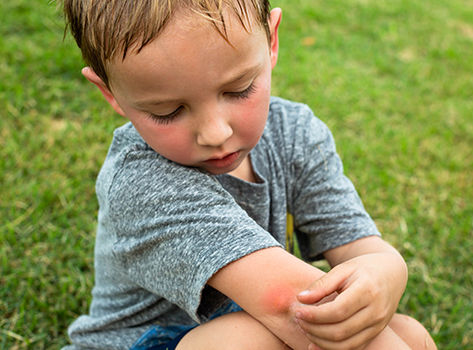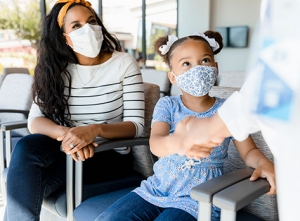
When children have an itch, they scratch it. This summer, kids will be scratching their insect bites, poison ivy and even impetigo, a contagious childhood skin infection. In most cases, scratching provides them some temporary relief – and usually the rash will subside with a few home remedies. But trouble arises when the scratching brings on a bacterial infection that can lead to other health concerns. That’s when you need to see a doctor.
“It’s hard to tell a kid not to scratch something that’s itchy,” says Dr. Maria Lavaia, a pediatrician with Atlantic Health System. She explains that many common skin rashes are preventable and often surface when the weather warms and children are outside exposed to plants, insects, and the environment. “Scratching the itch repeatedly can cause the rash to spread, disrupt the skin barrier, and increase the chance of infection.”
According to Dr. Lavaia, prevention starts with trimming your child’s nails and keeping them short, washing hands often, wearing clothing that covers and protects, and using insect repellants and sunscreens as recommended. She also cautions that a kid’s nose may harbor bacteria, so try to keep those little fingers from picking that too.
Here are three summertime rashes to keep an eye out for on little bodies.
1. Poison ivy, oak and sumac
Poison ivy, oak and sumac grow in wooded or damp areas, and some kids are more prone to contracting it than others. The oils of these plants can cause a rash to appear, sometimes within hours, other times days later. The rash typically shows up as patches or little blisters that can easily spread to all areas of the body.
- Prevent and avoid by teaching older children to recognize the plant leaves. If there’s known contact, thoroughly clean the contaminated skin with soap and water, and wash the clothes and shoes too. Calamine lotion or hydrocortisone creams will help keep kids comfortable, but avoid topical creams with anesthetics or antihistamines in them. These can cause allergic reactions.
- Call a doctor if the rash shows signs of infection or spreads to the face or genitals. In these cases, your child will likely need an oral steroid.
2. Insect bites and stings
Insect bites and stings are inevitable when kids are sharing parks and playgrounds with bees, wasps, mosquitos, ticks and fire ants. These critters cause itching and irritation at the very least, and in some cases can lead to more severe reactions. If cool compresses and oral antihistamines don’t seem to help, clean the affected area with rubbing alcohol and apply a first aid ointment like Bacitracin. You should remove a stinger by scraping it horizontally with your fingernail or credit card. To remove a tick, grasp it with tweezers and pull it straight up and out.
- Prevent and avoid by wearing long pants and socks. Dress in light-colored clothing to easily identify ticks and use insect repellant on exposed skin and clothing. Remember, repellents will help keep away bugs that bite, not bugs that sting.
- Call a doctor if your child is in significant pain or if you see signs of infection, fever, or a bull’s eye rash from a tick bite. Remember, infections can often look the same as the rash with swelling, redness, tenderness.
3. Impetigo
Impetigo is a common bacterial infection that can develop in the cuts, scrapes and insect bites kids get during the summertime months. It is contagious and can spread quickly, so it’s important to know how to identify it. This rash looks like crusted spots that ooze and scab. If you suspect impetigo, clean the affected area with soap and water and if it is localized, apply Neosporin or Bacitracin, then cover it to stop the spread.
- Prevent and avoid by washing hands regularly and trimming fingernails regularly to avoid introducing bacteria into the exposed tissue.
- Call your doctor if the infection spreads, becomes angry and swollen, or a fever develops. In these cases, your child will need an oral antibiotic to calm things down.
“There are so many common childhood rashes that itch, we could dedicate an entire textbook chapter to it.” says Dr. Lavaia. “If your child is scratching, there’s a reason, so pay attention to potential triggers. With the right care at home and working with your pediatrician, many of these issues will resolve themselves without having to see a dermatologist. We’re here to guide you so your child is safe and comfortable.”
Be Proactive About Their Health
Childhood rashes from plants, bugs and infections are common during summer months. With the right care at home and working with your pediatrician, we're here to guide you so your child is safe and comfortable.
Related Articles
Your Healthy Summer Guide
Atlantic Health System is your healthy summer guide to a safe and fun season. From helpful tips to preventive and urgent care, we've got you covered for whatever summer brings.
Help! Where Should I Take My Child for Care?
Unexpected accidents and illnesses happen all the time – so make sure you know where to go when a health emergency strikes.
5 Ways to Play It Safe at Summer Camp
Camp activities come with safety precautions. Here are five ways your little camper can play it safe while away from home.
Preparing Your Child for Summer Camp
Kids create memories that last a lifetime during summer camp. Follow these tips to help keep your child’s summer safe, healthy, and happy.
5 Cool Tips to Prevent Heat-Related Illness
Learn 5 tips to help you stay cool and safe during hot and sticky summers and avoid heat-related illness.
Protect Your Skin from Sun Damage this Season
Summertime activities bring us out in the sun. Whether it’s time spent at the beach, pool, park, or garden, it’s important to protect your skin from the glare of ultraviolet (UV) rays -- and lower your risk of potential skin damage.





